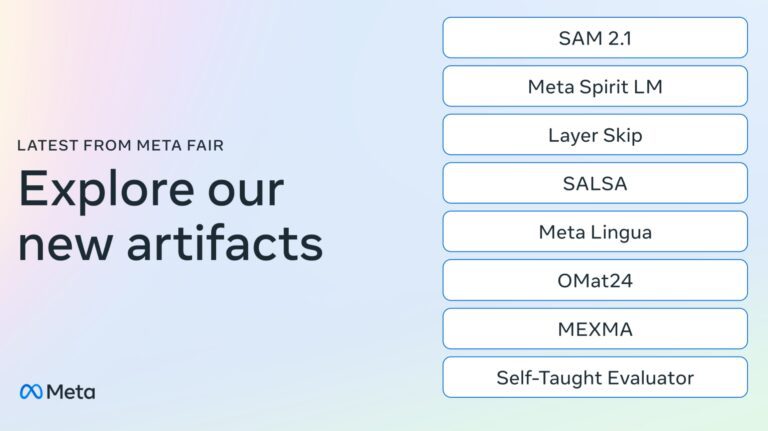Meta Spirit LM AI: A Breakthrough in Text and Speech Technology
As we approach Halloween 2024, Meta Spirit LM AI has made its debut, marking a significant milestone as Meta’s first open-source multimodal language model. This groundbreaking model allows seamless integration of both text and speech inputs and outputs, setting a new benchmark in artificial intelligence capabilities.
The Spirit LM AI directly competes with other leading multimodal models, including OpenAI’s GPT-4o and alternatives like Hume’s EVI 2. Furthermore, it stands shoulder to shoulder with established text-to-speech and speech-to-text systems, such as ElevenLabs.
Transforming Voice Experiences
The talented team at Meta’s Fundamental AI Research (FAIR) has designed Spirit LM AI to address the typical limitations encountered in current AI voice technologies. Traditional AI voice models often rely on automatic speech recognition (ASR) to interpret spoken words before merging them with a language model. This process eventually utilizes text-to-speech (TTS) techniques to produce sound output.
However, this standard methodology often sacrifices the richness of human voice, missing vital emotional tones and pitches. With Spirit LM AI, Meta introduces a sophisticated approach combining phonetic, pitch, and tone tokens. This innovation empowers the model to generate speech that embodies the natural expressiveness and subtleties of human interaction.
Two Unique Versions of Spirit LM AI
Meta has introduced two unique versions of Spirit LM AI designed to cater to different applications:
- Spirit LM Base: This version uses phonetic tokens for processing and generating speech.
- Spirit LM Expressive: An enhanced version equipped with additional tokens for pitch and tone. It can convey complex emotional states more effectively, such as joy or sadness.
Both models are trained on an extensive array of both text and speech datasets. This diverse training enables Spirit LM AI to perform cross-modal tasks, such as converting speech to text and vice versa, while preserving the authentic flow and expressiveness in its spoken outputs.
An Open-Source Model Promoting Research
Reflecting Meta’s commitment to open scientific research, Spirit LM AI is fully open-source. Researchers and developers can freely access the model weights, source code, and comprehensive documentation for experimentation and further development. However, users should be aware that the model’s current use is restricted to non-commercial applications. This licensing framework allows reproducing, modifying, and creating derivative works, provided they adhere to the non-commercial guidelines.
Through this initiative, Meta aims to inspire the AI research community to explore innovative methods for combining speech and text in automated systems.
Revolutionizing Text and Speech Integration
The architecture of Spirit LM AI transforms how AI systems process language, significantly enhancing traditional capabilities by incorporating emotional cues into speech generation. Some critical applications of the model encompass:
- Automatic Speech Recognition (ASR): Efficiently converts spoken language into written text.
- Text-to-Speech (TTS): Transforms written content into spoken language.
- Speech Classification: Identifies and categorizes spoken language based on content and emotional tone.
Moreover, the Spirit LM Expressive version elevates this functionality by accurately embedding emotional nuances within generated speech. It can recognize emotional tones like surprise, anger, or joy, resulting in more engaging and relatable interactions with AI.
Real-World Applications of Spirit LM AI
The potential applications of Spirit LM AI are extensive and impactful. This advanced AI model can significantly enhance various areas, including:
- Virtual Assistants: By providing more human-like interactions, these assistants can better understand and respond to user emotions.
- Customer Service Bots: AI interactions can become increasingly empathetic, thus improving overall customer experiences.
- Interactive AI Systems: Facilitating more nuanced interactions can lead to enhanced communication effectiveness.
Part of a Broader Vision for Advanced Machine Intelligence
As part of a larger mission, Spirit LM AI aligns with the objectives of Meta’s FAIR team, which strives to develop robust research tools and models. This includes advancements to existing technologies like the Segment Anything Model 2.1 (SAM 2.1), utilized in disciplines such as medical imaging and environmental studies.
Meta’s overarching aim remains the pursuit of advanced machine intelligence (AMI). By focusing on creating powerful yet accessible AI systems, the FAIR team dedicates its efforts to sharing research and advancing AI, ultimately benefiting society at large. The introduction of Spirit LM AI is a pivotal step in this commitment, driving open science and reproducibility while expanding the horizons of natural language processing technology.
The Future of Spirit LM AI
With the unveiling of Meta Spirit LM AI, we witness a transformative development in the integration of speech and text within AI systems. By presenting an approach that prioritizes natural and expressive speech generation while also making the model accessible for research, Meta lays the foundation for innovative applications in multimodal AI. The capabilities in ASR, TTS, and beyond offer exciting possibilities for a new era of human-like interactions powered by advanced artificial intelligence technology.




0 Comments